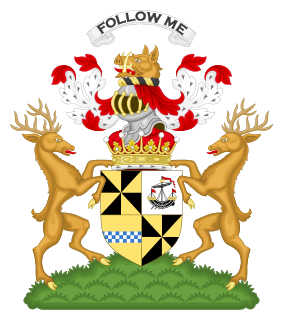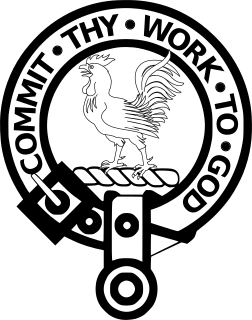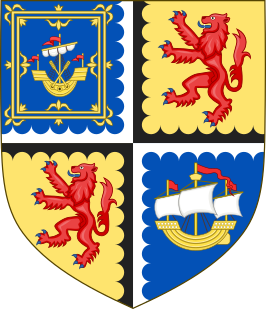Related Research Articles
William Sinclair (1410–1480), 1st Earl of Caithness (1455–1476), last Earl (Jarl) of Orkney, 2nd Lord Sinclair and 11th Baron of Roslin was a Norwegian and Scottish nobleman and the builder of Rosslyn Chapel, in Midlothian.

Earl of Caithness is a title that has been created several times in the Peerage of Scotland, and it has a very complex history. Its first grant, in the modern sense as to have been counted in strict lists of peerages, is now generally held to have taken place in favor of Maol Íosa V, Earl of Strathearn, in 1334, although in the true circumstances of 14th century, this presumably was just a recognition of his hereditary right to the ancient earldom/mormaership of Caithness. The next year, however, all of his titles were declared forfeit for treason.

Lord Sinclair is a title in the Peerage of Scotland. According to James Balfour Paul's The Scots Peerage, volume VII published in 1910, the first person to be styled Lord Sinclair was William Sinclair, 3rd Earl of Orkney and 1st Earl of Caithness. However, according to Roland Saint-Clair writing in the late 19th century, William Sinclair's father, Henry II Sinclair, Earl of Orkney, who died in 1420, is the first person recorded as Lord Sinclair by public records.

Earl of Breadalbane and Holland is a title in the Peerage of Scotland. It was created in 1681 for Sir John Campbell, 5th Baronet, of Glenorchy, who had previously been deprived of the title Earl of Caithness.

Clan Sutherland is a Highland Scottish clan whose traditional territory is the shire of Sutherland in the far north of Scotland. The chief of the clan was also the powerful Earl of Sutherland, however in the early 16th century this title passed through marriage to a younger son of the chief of Clan Gordon. The current chief is Alistair Sutherland who holds the title Earl of Sutherland.

Clan Sinclair is a Highland Scottish clan who held lands in Caithness, the Orkney Islands, and the Lothians. The chiefs of the clan were the Barons of Roslin and later the Earls of Orkney and Earls of Caithness. The Sinclairs are believed to have come from Normandy to England during the Norman conquest of England, before arriving in Scotland in the 11th century. The Sinclairs supported the Scottish Crown during the Scottish–Norwegian War and the Wars of Scottish Independence. The chiefs were originally Barons of Roslin, Midlothian and William Sinclair, 1st Earl of Caithness and Baron of Roslin founded the famous Rosslyn Chapel in the 15th century. He split the family lands, disinheriting his eldest son from his first marriage, William, who inherited the title of Lord Sinclair, instead giving the lands of Caithness to the second son from his second marriage, William Sinclair, 2nd Earl of Caithness, in 1476, and the lands at Roslin to his eldest son from his second marriage, Sir Oliver Sinclair. In the 16th century the Sinclairs fought against England during the Anglo-Scottish Wars and also feuded with their neighbors the Clan Sutherland. During the Jacobite rising of 1715 the Sinclairs supported the Jacobite cause, but during the Jacobite rising of 1745, while the clan largely had Jacobite sympathies, their chief, the Earl of Caithness, supported the British-Hanoverian Government. The current chief is Malcolm Sinclair, 20th Earl of Caithness.

Baron of Roslin or Rosslyn was a Scottish feudal barony held by the St Clair or Sinclair family.

William Sinclair was a nobleman, the 2nd Earl of Caithness and chief of the Clan Sinclair, a Scottish clan of the Scottish Highlands.

John Sinclair was a Scottish nobleman, 3rd Earl of Caithness and chief of the Clan Sinclair, a Scottish clan of the Scottish Highlands.
James Sinclair, 12th Earl of Caithness was a Scottish noble, Earl of Caithness and chief of the Clan Sinclair, a Highland Scottish clan.
The 76th Regiment of Foot , sometimes referred to as 'MacDonnell's Highlanders' after its colonel, John MacDonnell of Lochgarry, was a Scottish Light Infantry regiment raised in the west of Scotland and western isles of Scotland in 1777.

George Sinclair was a Scottish nobleman, the 4th Earl of Caithness and chief of the Clan Sinclair, a Scottish clan of the Scottish Highlands.
John Sinclair, Master of Caithness was a Scottish nobleman and chief of the Clan Sinclair, a Scottish clan of the Scottish Highlands.

George Sinclair was a Scottish nobleman, the 5th Earl of Caithness and chief of the Clan Sinclair, a Scottish clan based in northern Scotland.

George Sinclair was a Scottish nobleman, 6th Earl of Caithness, and chief of the Clan Sinclair, a Scottish clan of the Scottish Highlands.

George Sinclair, previously of Keiss, died 1698, was a Scottish nobleman, 7th Earl of Caithness and chief of the Clan Sinclair, a Scottish clan of the Scottish Highlands.

John Sinclair was a Scottish nobleman, 8th Earl of Caithness and chief of the Clan Sinclair, a Scottish clan of the Scottish Highlands.
Alexander Sinclair, 9th Earl of Caithness was a Scottish nobleman, Earl of Caithness and chief of the Clan Sinclair, a Highland Scottish clan in Caithness.
William Sinclair, 10th Earl of Caithness, was a Scottish nobleman, Earl of Caithness and chief of the Clan Sinclair, a Highland Scottish clan in Caithness.
Alexander Gordon, 12th Earl of Sutherland was a Scottish landowner.
References
- ↑ Saint-Clair, Roland William (1898). The Saint-Clairs of the Isles; being a history of the sea-kings of Orkney and their Scottish successors of the sirname of Sinclair. Shortland Street, Auckland, New Zealand: H. Brett. pp. 215 . Retrieved 6 February 2021.
- 1 2 3 4 Henderson, John W.S (1884). Caithness Family History. Edinburgh: David Douglas. pp. 11-12.
- 1 2 3 4 5 Anderson, William (1862). The Scottish Nation: Or The Surnames, Families, Literature, Honours, and Biographical History of the People of Scotland. Vol. 1. p. 525.
- ↑ "The Earldom of Caithness - New Light on the Succession". Northern Ensign (PDF). 12 November 1889. p. 106. Retrieved 18 July 2020.
Lieutenant-Colonel John Sinclair, the reputed eleventh earl, was buried on 13th April, 1789, at St. Marylebone churchyard.., and...dying suddenly at London, 8th April, 1789, in the 33rd year of his age
- ↑ Hawkins, Ann R; Eckroth, Stephanie (2020). Romantic Women Writers Reviewed. Vol. Part I, Volume 3. p. (no page numbers). ISBN 9781000748505 . Retrieved 18 July 2020.
In 1779 he succeeded to the title of eleventh Earl of Caithness; he committed suicide by shooting himself in 1789